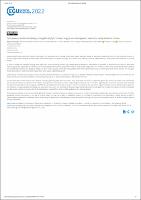| dc.contributor.author | Arestegui, Miguel | |
| dc.contributor.author | Ordoñez, Miluska | |
| dc.contributor.author | Cisneros, Abel | |
| dc.contributor.author | Madueño, Giorgio | |
| dc.contributor.author | Almeida, Cinthia | |
| dc.contributor.author | Aliaga Nestares, Vannia | |
| dc.contributor.author | Quispe, Nelson | |
| dc.contributor.author | Millán Arancibia, Carlos | |
| dc.contributor.author | Lavado-Casimiro. W. | |
| dc.contributor.author | Huaman, Samuel | |
| dc.contributor.author | Phillips, Jeremy | |
| dc.date.accessioned | 2022-04-06T20:37:01Z | |
| dc.date.available | 2022-04-06T20:37:01Z | |
| dc.date.issued | 2022 | |
| dc.identifier.uri | https://hdl.handle.net/20.500.12542/1906 | |
| dc.description.abstract | Heavy rainfall, floods and debris flow on the Rimac river watershed are recurring events that impact Peruvian people in vulnerable situations.There are few historical records, in terms of hydrometeorological variables, with sufficient temporal and spatial accuracy. As a result, Early Warning Systems (EWS) efficiency, dealing with these hazards, is critically limited.
In order to tackle this challenge, among other objectives, the Participatory Monitoring Network (Red de Monitoreo Participativo or Red MoP, in spanish) was formed: an alternative monitoring system supported by voluntary community collaboration of local population under a citizen science approach. This network collects and communicates data captured with standardized manual rain gauges (< 3USD). So far, it covers districts in the east metropolitan area of the capital city of Lima, on dense peri-urban areas, districts on the upper Rimac watershed on rural towns, and expanding to other upper watersheds as well.
Initially led by Practical Action as part of the Zurich Flood Resilience Alliance, it is now also supported by SENAMHI (National Meteorological and Hydrological Service) and INICTEL-UNI (National Telecommunications Research and Training Institute), as an activity of the National EWS Network (RNAT). | es_PE |
| dc.format | application/pdf | es_PE |
| dc.language.iso | spa | es_PE |
| dc.publisher | European Geosciences Union | es_PE |
| dc.relation.uri | https://meetingorganizer.copernicus.org/EGU22/EGU22-13115.html | es_PE |
| dc.relation.uri | https://doi.org/10.5194/egusphere-egu22-13115 | es_PE |
| dc.rights | info:eu-repo/semantics/openAccess | es_PE |
| dc.rights | Atribución-NoComercial-SinDerivadas 3.0 Estados Unidos de América | * |
| dc.rights.uri | http://creativecommons.org/licenses/by-nc-nd/3.0/us/ | * |
| dc.source | Repositorio Institucional - SENAMHI | es_PE |
| dc.source | Servicio Nacional de Meteorología e Hidrología del Perú | es_PE |
| dc.subject | Hidrometeorología | es_PE |
| dc.subject | Lluvia | es_PE |
| dc.subject | Gestión de Riesgo | es_PE |
| dc.subject | Rainfall Monitoring | es_PE |
| dc.title | Participatory rainfall monitoring: strengthening hydrometeorological risk management and community resilience in Peru | es_PE |
| dc.type | info:eu-repo/semantics/report | es_PE |
| dc.subject.ocde | https://purl.org/pe-repo/ocde/ford#1.05.11 | es_PE |
| dc.publisher.country | PE | es_PE |
| dc.subject.sinia | precipitacion - Clima y Eventos Naturales | |
| dc.type.sinia | text/libro.presentacion | |
| dc.identifier.url | https://hdl.handle.net/20.500.12542/1906 | |









